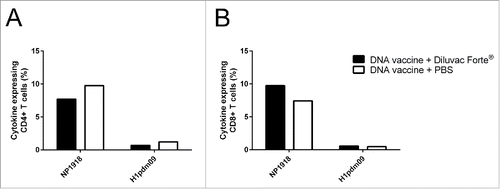Figures & data
Figure 1. The effect of Diluvac Forte® on IgG titers after DNA immunization. Serum IgG anti-H1pdm09 (A) and anti-NP1918 (B) induced by the immunization of mice with a DNA vaccine (50 µg DNA/mice/immunization time point) mixed with Diluvac Forte or PBS. CB6F1 mice (n = 8/group) were immunized at day 0 and 21. Blood samples were collected at day 14 and day 35 for all animals and at day 42 and 50 from 4 animals/group. The antibody titers are expressed as the reciprocal of the sample dilution giving an optical density (OD) value of 1.0 (A) or 0.5 (B). The data are presented as the mean ± standard error of the mean (SEM). ***: p < 0.001; **: p < 0.01; *: p < 0.05 comparing the 2 groups.
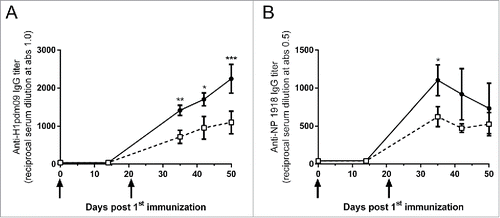
Figure 2. The effect of Diluvac Forte® on IgG, IgG1 and IgG2c titers after DNA and protein immunization. Mice were vaccinated twice (on day 0 and 21) i.d. with 1 µg protein or 50 µg DNA with or without Diluvac (n = 4 in each group). The levels of IgG (A), IgG1 (B) and IgG2c (C) in the sera at day 35 were measured by ELISA against the recombinant influenza H1pdm09 protein. The antibody titers are expressed as the reciprocal of the sample dilution giving an optical density (OD) value of 1.0. The error bars indicate mean ± SEM. If the groups differ significantly (p < 0.05), then the p-value is indicated. If the groups are not significantly different, then the p-value is not shown.
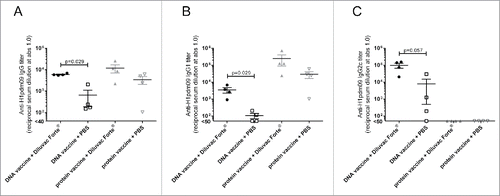
Figure 3. The effect of α-tocopherol on IgG titers after DNA immunization. Serum IgG anti-H1pdm09 (A) and anti-NP 1918 (B) at day 35 induced by immunization of mice with a DNA vaccine (50 µg DNA/mice/immunization time-point) mixed with α-tocopherol at high (150 mg/ml) medium (100 mg/ml) and low (50 mg/ml) concentrations in an emulsion, emulsion without α-tocopherol or PBS. CB6F1 mice (n = 6/group) were immunized at day 0 and 21. The antibody titers are expressed as the reciprocal of the sample dilution giving an optical density (OD) value of 1.0. The error bars indicate the mean ± SEM. If the groups differ significantly (p < 0.05), then the p-value is indicated. If the groups are not significantly different, then the p-value is not shown.
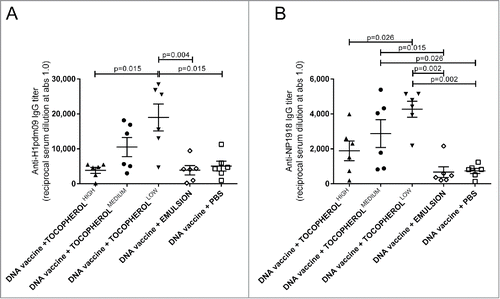
Figure 4. The effect of α-tocopherol on IgG1 and IgG2c titers after DNA immunization. Serum IgG1 (A) and IgG2c (B) anti-H1pdm09 at day 35 induced by immunization of mice with DNA vaccine (50 µg DNA/mice/immunization time-point) mixed with α-tocopherol at high (150 mg/ml) medium (100 mg/ml) and low (50 mg/ml) concentrations in an emulsion, emulsion without α-tocopherol or PBS. CB6F1 mice (n = 6/group) were immunized at day 0 and 21. The antibody titers are expressed as the reciprocal of the sample dilution giving an optical density (OD) value of 1.0. The error bars indicate the mean ± SEM. If the groups differ significantly (p < 0.05), then the p-value is indicated. If the groups are not significantly different, then the p-value is not shown.
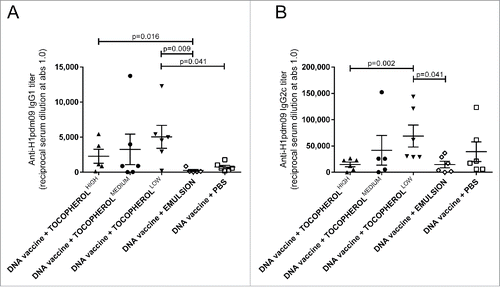
Figure 5. The effect of Diluvac Forte® on (T)cell responses after DNA immunization. The total cytokine response, including IFNγ, TNF and/or IL-2, in CD4+ T cells (A) and CD8+ T cells (B) upon restimulation of the splenocytes isolated from the CB6F1 mice (Balb/C × C57BL/6) immunized with a DNA vaccine with/without Diluvac Forte at day 0 and 21 (n = 4 in each group). The splenocytes from day 35 were cultured in vitro in the presence of recombinant influenza NP1918 (5 mg/mL) or H1pdm09 (5 mg/mL). After 24 h, the cytokine response was analyzed by intracellular cytokine staining followed by flow cytometry. PMA plus ionomycin was included as positive control, and media alone served as the negative control (data not shown).
